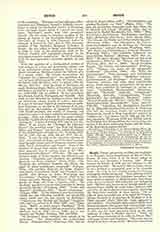

Heude, PIERRE, missionary to China and zoologist; b. at Fougeres, in the Department of Ille-et-Vilaine, France, June 25, 1836; d. in the Jesuit college at Zi-ka-wei, near Shanghai, January 3, 1902. Heude entered the Society in 1856 and was ordained to the priesthood in 1867. He went in 1868 to China, where he was destined to accomplish most of his scientific work. As a boy he had secured a manual of botany and eagerly studied its secrets. Even after his arrival in China he continued his botanical researches, but soon turned to zoology, in which for more than thirty years he was to labor with admirable and unflagging zeal. His first step was to travel through middle and eastern China, chiefly by water routes, between 1868 and 1881, his chief subjects of investigation then being the fresh-water molluscs of those regions. The results of these researches are to be found in “Conchyliologie fluviatile de la province de Nanking et de la Chine centrale” (Paris, 1876-85), which appeared in ten numbers. It contained eighty plates which made known numerous new species and received high commendation from the scientific colleagues of the author. To this day the most important work on the land molluscs of China is Heude’s treatise: “Notes sur les mollusques terrestres de la vallee du Fleuve Bleu” (188 pages of text and 32 plates). This essay may be found in the first volume of the “Memoires concernant l’histoire naturelle de l’Empire Chinois” (Shanghai, Imprimerie de la Mission Catholique), founded by the Jesuits of Zi-ka-wei in 1882. Of these “Memoires” there had appeared at the time of Heude’s death four volumes, of four numbers each, and the first number of volume V, containing in all more than 800 pages and, in round numbers, 200 illustrations and plates, partly colored, in royal folio. There is in the first volume a short article by P. C. Rathouis; the rest is due to the pen of Father Heude, who by this time had taken up the study of mammals. He had in the meanwhile (1881-83) founded, with the cooperation of a number of missionaries, a museum in Zi-ka-wei for the natural history of Eastern Asia, and had visited Europe to study the great museums of natural history in Paris, London, Antwerp, and Leyden.
Henceforth he directed his studies particularly to the systematic and geographical propagation of Eastern Asiatic species of mammals, as well as to a comparative morphology of classes and family groups according to tooth-formation and to skeleton. His fitness for this work arose from an extremely keen eye, an accurate memory, and the enormous wealth of material which he partly accumulated in the course of his earlier travels, partly found in the museum of Zi-ka-wei, and partly ferreted out in new expeditions which he undertook in all directions. These expeditions covered chiefly the years from 1892 to 1900. They took him to the Philippines (which he visited three times), to Singapore, Batavia, the Celebes, the Moluccas, New Guinea, Japan, Vladivostock, Cochin-China, Cambodia, Siam, Tongking. Volumes II to V of the “Memoires” give the results of these studies in numerous articles which treat practically of all classifications of mammals, notably the “Etudes odontologiques”, and, lastly, discuss the tooth-formation of the anthropoid apes and of man. As an investigator in connection with his morphological treatises Heude carried on his work with absolute independence of method. He contented himself with the facts before him and sought little assistance from authorities. He did not fear to deduce theoretical conclusions from his own observations, which flatly contradicted the views of other investigators—e.g., Rutimeyer—consequently, he was drawn into controversies. Heude fell seriously ill at Tongking in July, 1900 (his travelling diary, which he kept scrupulously up to date, began in November, 1867, and ended July 22, 1900), and after October, 1900, resided in Zi-ka-wei, where, though in bad health, he continued his scientific work until just before his death.
JOSEPH ROMPEL

